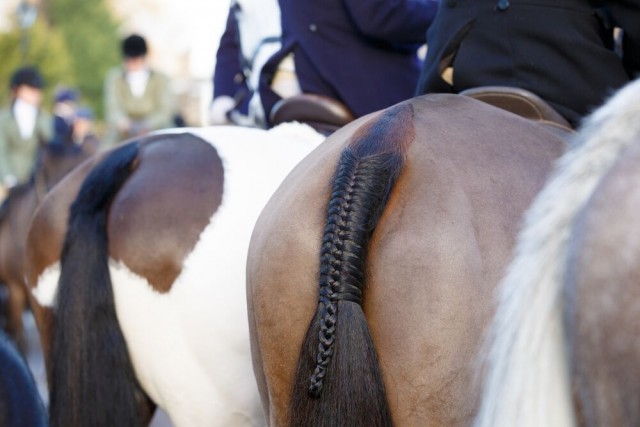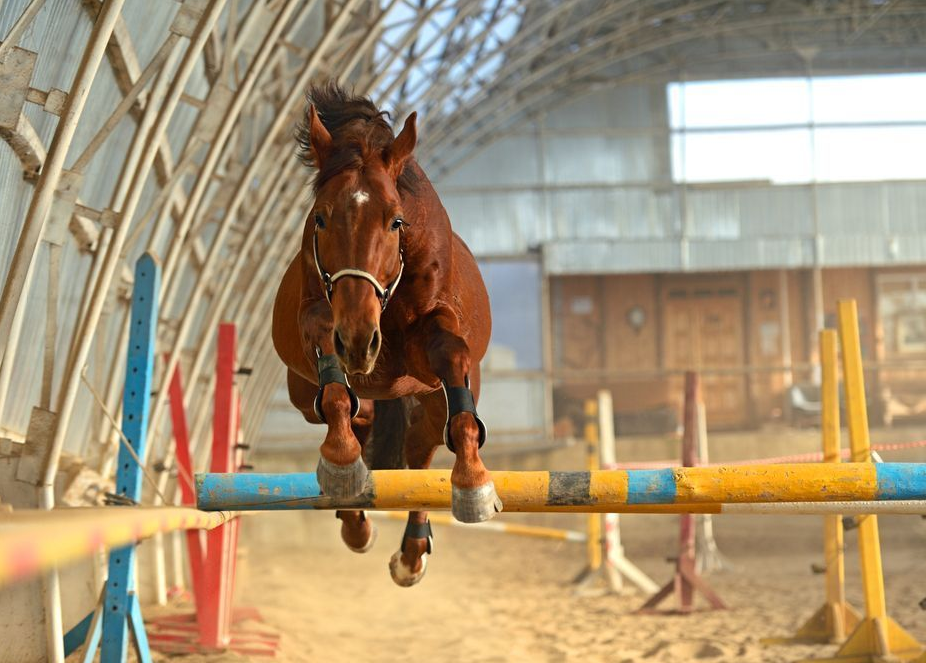#THE ATHLETIC RIDER
#TBT: Rider Fitness Tip — Cardiorespiratory Training
Uh oh, the dreaded cardio workout … Leah Hinnefield of The Athletic Rider outlines why cardiorespiratory training is crucial for riders.
Does This Saddle Make My Butt Look Big?
While working toward fitness goals is a worthwhile endeavor, it’s also important to love the body you’re living in today. Equestrian fitness coach Leah Hinnefield of The Athletic Rider explains. (more…)
The Athletic Rider: Dead Man Walking
Sure, you need to be relaxed in the saddle … but how much is too much? Equestrian personal trainer Leah Hinnefield outlines how to practice correct engagement. (more…)
The Athletic Rider: Developing Your ‘Canter Fitness’
Committing to a fitness program can be a leap of faith in that you may not always see the results immediately. Equestrian personal trainer Leah Hinnefeld discusses trusting the process.
The Athletic Rider: Farrier Fitness, Part IV
Hoof care professionals have incredibly demanding jobs, requiring the physicality of weightlifters, the skill of craftsmen and the patience of saints. All that hard work takes its toll and is the focus of a series by equestrian personal trainer Leah Hinnefeld.
The Athletic Rider: The Hay Bale Circuit
Who needs a gym when you’ve got a loft full of hay?
The Athletic Rider: Farrier Fitness, Part I
Hoof care professionals have incredibly demanding jobs, requiring the physicality of weightlifters, the skill of craftsmen and the patience of saints. All that hard work takes its toll and is the focus of a new series by equestrian personal trainer Leah Hinnefeld.
In Part 1 of the HCP series, I identified three postural distortions common to most people-and for our purposes, common specifically to hoof care professionals (HCPs). In part 2, I will identify the specific activity in the HCP that exacerbates the pronation distortion syndrome, then offer suggestions on flexibility and strengthening exercises that could be part of a complete training program.
The first common postural distortion is the Pronation Distortion Syndrome. This distortion is characterized by a knock kneed appearance that is often accompanied with a flat foot, or inwardly rotated foot position.
Doesn’t this look just a little familiar to the position an HCP holds when he has a hoof between his legs to clean, trim and shoe a horse. This means that a posture issue that is already present in most people is reinforced for hours each working day for the HCP. Common injuries that occur with this distortion and the accompanying muscular imbalances are not addressed include: plantar fasciitis, shin splints, patellar (knee) tendonitis and low back pain. No wonder your otherwise chipped HCP may not be his jovial self after attending to the needs of a show barn full of horses!
Pronation Distortion Syndrome (and each common postural distortion) is a result of certain muscles maintaining a shortened or contracted position and opposing muscles painting a lengthen position. The muscular imbalance leads to altered joint mechanics and often results in one or more of injures mentioned above. The knock kneed appearance can be a result of a shortened adductor muscle (inner thigh) and a lengthened gluteus medius/maximus muscle (outer butt cheeks).
A combination of foam rolling the inner thigh, adductor stretches and strengthening exercises (like tube walking) targeted to those specific gluteal muscles can restore the imbalance, prevent further imbalance and provide an environment for correct join function (not to mention reduce pain).
Because there is more than one muscle that contributes to this distortion and because each individual is unique, it is recommended to contact a personal trainer who is skilled in identifying muscular imbalances through postural assessments to provide a custom designed program. The Athletic Rider offers this service virtually should you not be able to find a local certified personal trainer in your area. Just CONTACT The Athletic Rider to schedule your online assessment.
*postural distortion image courtesy of Clark, Michael A., Sutton, Brian G., Lucett, Scott C., NASM Essentials of Personal Fitness Training, 4th Ed., 2014. Jones & Bartless Learning. p. 134-136.
Leah Hinnefeld is a lifelong equestrian who spent over a decade studying hoof health and metabolism in horses before turning her attention to rider fitness. Leah is a personal trainer certified by the National Academy of Sports Fitness and offers Virtual Fitness Training for riders and horse lovers. You can learn more about how to get fit to ride at http://theathleticrider.
The Athletic Rider: Farrier Fitness, Part I
Hoof care professionals have incredibly demanding jobs, requiring the physicality of weightlifters, the skill of craftsmen and the patience of saints. All that hard work takes its toll and is the focus of a new series by equestrian personal trainer Leah Hinnefeld.
The Athletic Rider Strength Series: Core Strength
Equestrian personal trainer Leah Hinnefeld’s popular series on strength training for riders concludes with this week’s grand finale. The topic: core strength.
The Athletic Rider: Lower Body Strength
Equestrian personal trainer Leah Hinnefeld’s popular series on strength training for riders continues with this week’s topic: lower body strength. (more…)
The Athletic Rider: Upper Body Strength
Personal trainer/equestrian Leah Hinnefeld’s Rider Fitness Strength Series continues with Part II, focusing on upper body strength.
The Athletic Rider Strength Series: Muscular Stabilization
Want to get stronger in the saddle? Personal trainer and equestrian Leah Hinnefeld explains that it starts on the ground.
The Athletic Rider: 10 Tips for Eating Clean on the Road
Going to a horse show doesn’t mean you get to ditch your diet and hit the concession stand. Personal trainer Leah Hinnefeld explains that a little planning ahead goes a long way. (more…)
The Athletic Rider: Long in the Tooth, Loose in the Cage?
By Leah Hinnefeld
I am not sure if any of us remember the exact moment when it happened, but one thing we do know: At some point, for some of us (OK most of us) there was a fork in the trail and our minds went right (still thinking we were 18-25 years old) and our bellies, triceps and saddlebags went left. Maybe it happened after getting a “real job” or maybe after having a baby or maybe it just… happened!
Are you a rider over say…. 35-40 years old? Or one rapidly approaching that mystical cut-off age where the identity of a young adult is replaced with one of (dare I say) middle age? If you are, I bet you can fondly look back to those days when you could ride all day, show all weekend, even eat horse show food at that show… and never gain a pound. I know I could! Shoot, in college I could polish off a pizza with friends and “jog it off” with a five-mile run the next day! OK, maybe not literally, but it sure seems that way in my mind and looking back on old sorority photos!
I speak to so many riders who lament the loss of those athletic riding bodies from earlier years and wonder if anything could have been done or can be done to implement some damage control.
So today I am going to ask and answer that question on the mind of every “rider of a certain age” and the one that should be on the mind riders of every age:
Does Long in the Tooth Have to Mean Loose in the Cage†?
The fact is that approximately 95% of adults (riders or not) will show a 2-4% decline in resting metabolic rate each decade after the age of 25. This decline in metabolic rates is usually accompanied by a 5-lb loss of muscle mass during each of those same decades.
What does this mean in terms of the scale and how my breeches or chaps will fit?
It means that if I could eat 1,500 calories per day at age 25 and maintain my weight weight, I could only eat 1,200 at age 65 or I would GAIN weight.
It means that I would gain 31 POUNDS during those 40 years if I continued to eat 1,500 calories per day and nothing else changed.
UGH!
Is there anything I can do to prevent the loose cage, tush and tri syndrome?
Absolutely!
A properly designed exercise program will help prevent muscle loss and replace the muscle that has already been lost — with proper nutrition, of course.
There is a catch, though: The program needs to be designed to include intense exercise. OK, there are actually two catches. For most of us, riding will not qualify as intense exercise. Intense exercise includes activities like circuit training, hill running and a favorite in the Athletic Rider Fit Club — burpees!
Won’t riding help at all?
Riding is a calorie burner — no question about that; however, riding alone will not give a “post-exercise metabolic boost” that happens with intense exercise. This boost causes your body to burn additional calories even after you complete your intense workout. Riding will also not build muscle, an essential player in keeping your metabolism high, even when resting.
Bottom Line? Every rider needs a fitness program that is tailored to her current fitness level and future goals — no matter what age he or she is. The Athletic Rider Fitness Boot Camp was created to give all riders a 60-day jump start to developing that lifelong habit of fitness and health.
† Loose in the cage is hip young phrase that refers to those “less than” six-pack abs.
Leah Hinnefeld is a lifelong equestrian who spent over a decade studying hoof health and metabolism in horses before turning her attention to rider fitness. Leah is a personal trainer certified by the National Academy of Sports Fitness and offers Virtual Fitness Training for riders and horse lovers. You can learn more about how to get fit to ride at http://theathleticrider.
The Athletic Rider: Stay on Track During the Holidays
The Athletic Rider is here for you with a special offer that will help you not just survive, but thrive during this hectic, calorie-dense time of the year. (more…)
The Athletic Rider: Exercise Makes a Stable Rider
Sure, exercising is healthy for your body — but did you know that it’s nourishing for your mind as well? (more…)
The Athletic Rider: Muck Without Pain
Personal trainer Leah Hinnefeld demonstrates how small differences in mucking technique can make a big difference in preventing muscle strain.
The Athletic Rider: Turn Frustration Into Fascination
Especially when you’re in the early stages of a fitness program, it’s easy to feel discouraged. Personal trainer Leah Hinnefeld suggests a different approach. (more…)
The Athletic Rider: Hop, Skip and Jump to Rider Fitness
Don’t worry, we’re not talking about Prancercise. Personal trainer Leah Hinnefeld explains the benefits of agility training. (more…)
The Athletic Rider: The Missing Link
You have the desire to get fit, and you know what you need to do to accomplish your goals. But do you have accountability? Personal trainer Leah Hinnefeld explains. (more…)
The Atheletic Rider: Get a HANDle on Portion Control
Personal trainer Leah Hinnefeld demonstrates a practical approach to counting calories. (more…)
The Athletic Rider: Rider Fitness Tip — The Incline Pushup
Personal trainer Leah Hinnefeld demonstrates (using a hay bale, naturally!) the incline pushup, a super exercise for core stability and strength. (more…)
The Athletic Rider: Are You ‘Behind The Leg’ Toward Rider Fitness?
It’s important to be forward-thinking when it comes to your fitness journey, explains personal trainer Leah Hinnefeld. (more…)
The Athletic Rider: Core Engagement in the Saddle
Every rider should focus on developing core strength but if you don’t engage your core properly when riding, all the work won’t help a bit! Personal trainer Leah Hinnefeld shares some tips. (more…)





























